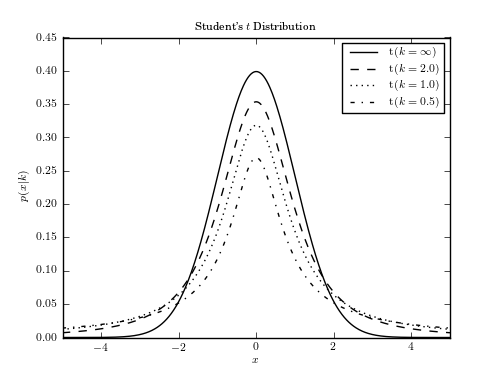Example of Student’s t distribution¶
Figure 3.15.
This shows an example of Student’s t distribution with various parameters. We’ll generate the distribution using:
dist = scipy.stats.student_t(...)
Where ... should be filled in with the desired distribution parameters Once we have defined the distribution parameters in this way, these distribution objects have many useful methods; for example:
- dist.pmf(x) computes the Probability Mass Function at values x in the case of discrete distributions
- dist.pdf(x) computes the Probability Density Function at values x in the case of continuous distributions
- dist.rvs(N) computes N random variables distributed according to the given distribution
Many further options exist; refer to the documentation of scipy.stats for more details.

# Author: Jake VanderPlas
# License: BSD
# The figure produced by this code is published in the textbook
# "Statistics, Data Mining, and Machine Learning in Astronomy" (2013)
# For more information, see http://astroML.github.com
# To report a bug or issue, use the following forum:
# https://groups.google.com/forum/#!forum/astroml-general
import numpy as np
from scipy.stats import t as student_t
from matplotlib import pyplot as plt
#----------------------------------------------------------------------
# This function adjusts matplotlib settings for a uniform feel in the textbook.
# Note that with usetex=True, fonts are rendered with LaTeX. This may
# result in an error if LaTeX is not installed on your system. In that case,
# you can set usetex to False.
from astroML.plotting import setup_text_plots
setup_text_plots(fontsize=8, usetex=True)
#------------------------------------------------------------
# Define the distribution parameters to be plotted
mu = 0
k_values = [1E10, 2, 1, 0.5]
linestyles = ['-', '--', ':', '-.']
x = np.linspace(-10, 10, 1000)
#------------------------------------------------------------
# plot the distributions
fig, ax = plt.subplots(figsize=(5, 3.75))
for k, ls in zip(k_values, linestyles):
dist = student_t(k, 0)
if k >= 1E10:
label = r'$\mathrm{t}(k=\infty)$'
else:
label = r'$\mathrm{t}(k=%.1f)$' % k
plt.plot(x, dist.pdf(x), ls=ls, c='black', label=label)
plt.xlim(-5, 5)
plt.ylim(0.0, 0.45)
plt.xlabel('$x$')
plt.ylabel(r'$p(x|k)$')
plt.title("Student's $t$ Distribution")
plt.legend()
plt.show()
